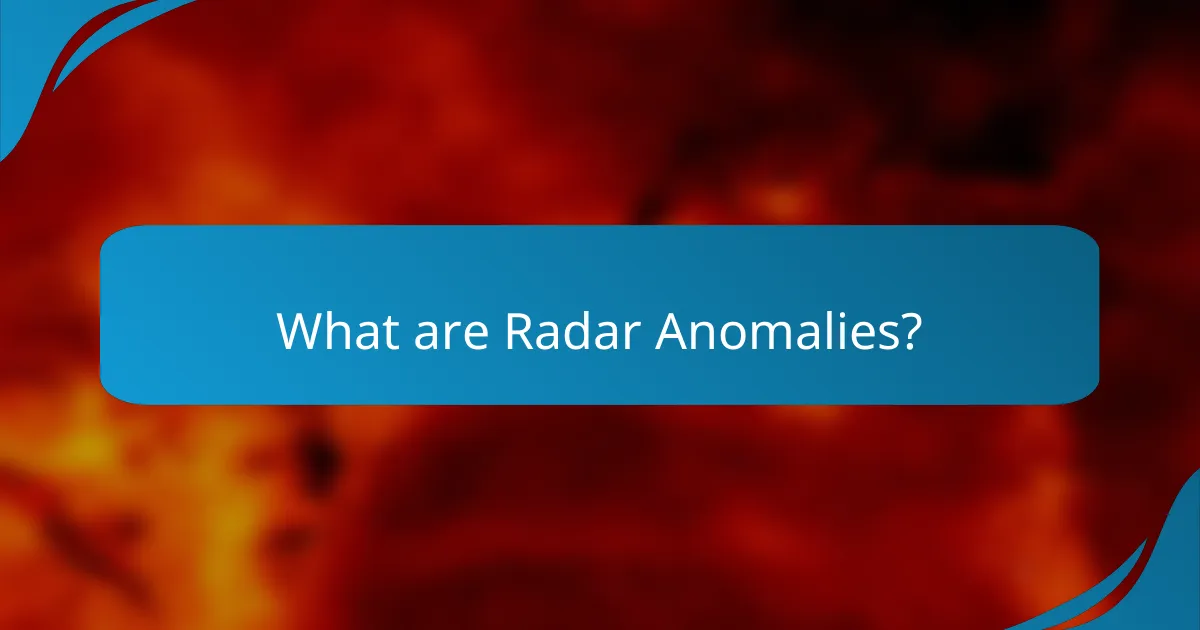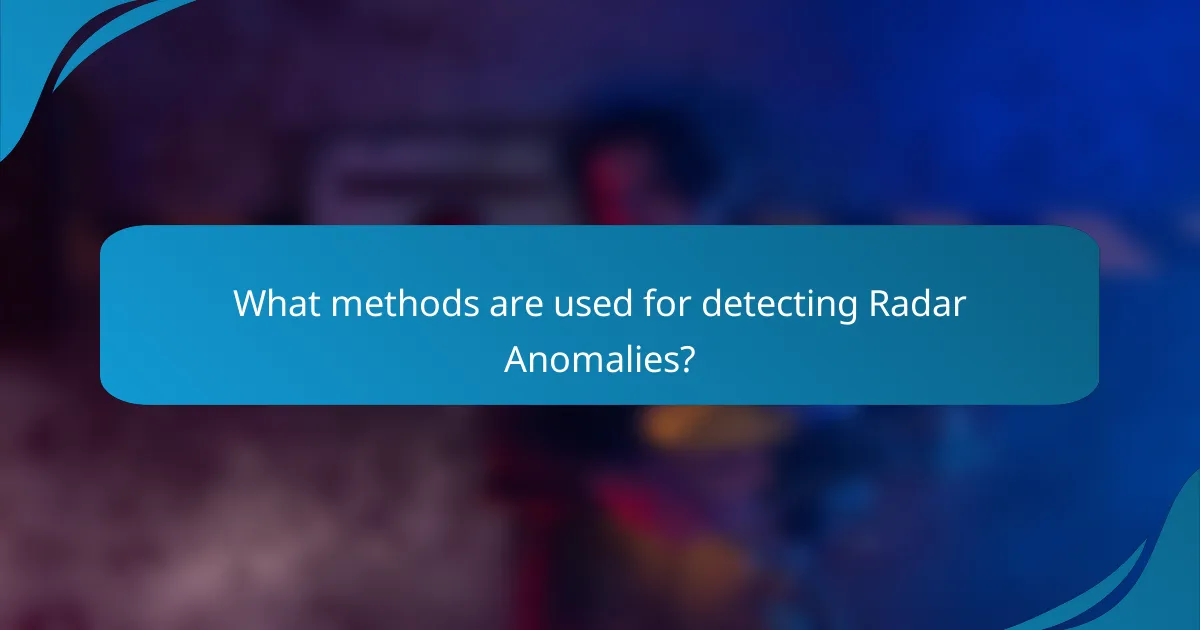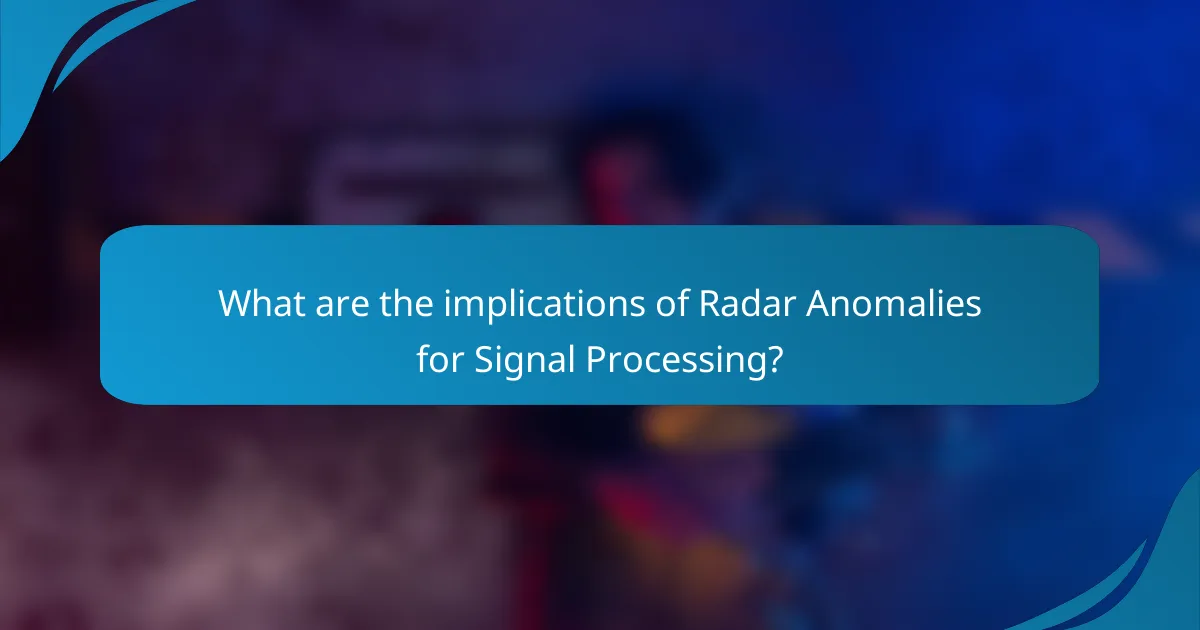Radar anomalies are unexpected signals detected by radar systems, resulting from environmental factors, equipment malfunctions, or interference. These anomalies can lead to errors in data interpretation, affecting signal processing accuracy and target detection capabilities. The article explores the various causes of radar anomalies and outlines detection methods such as signal processing algorithms, machine learning models, and statistical analysis. Additionally, it emphasizes the importance of addressing these anomalies to enhance radar system reliability and improve overall performance in target tracking. Understanding radar anomalies is essential for optimizing signal processing techniques and ensuring accurate data interpretation.

What are Radar Anomalies?
Radar anomalies are unexpected or unusual signals detected by radar systems. These anomalies can arise from various sources, including environmental factors, equipment malfunctions, or interference from other signals. For example, atmospheric conditions like precipitation or temperature inversions can cause radar signals to scatter or reflect abnormally. Additionally, radar systems may pick up false targets due to clutter or electronic noise. Understanding these anomalies is crucial for improving radar accuracy and reliability. Studies have shown that effective detection and analysis of radar anomalies can enhance signal processing techniques.
How do Radar Anomalies occur?
Radar anomalies occur due to various factors affecting signal propagation. These factors include atmospheric conditions, terrain interference, and equipment malfunctions. Atmospheric conditions such as temperature inversions can bend radar waves, causing unexpected returns. Terrain features like mountains can block or reflect signals, creating false targets. Equipment malfunctions, such as faulty radar components, can generate erroneous readings. Additionally, electronic interference from other devices may disrupt radar signals. Each of these factors can lead to misinterpretations of radar data, highlighting the complexity of radar signal processing.
What environmental factors contribute to Radar Anomalies?
Environmental factors that contribute to radar anomalies include precipitation, temperature inversions, and terrain. Precipitation, such as rain or snow, can scatter radar signals, leading to false returns. Temperature inversions can cause radar waves to bend, resulting in unexpected reflections. Terrain features, like mountains or buildings, can obstruct or reflect radar signals, creating additional anomalies. Atmospheric conditions, including humidity and wind, also play a role in radar performance. For instance, high humidity can enhance signal scattering. These factors collectively influence the reliability of radar systems and can lead to misinterpretations of the data.
How do equipment limitations lead to Radar Anomalies?
Equipment limitations can lead to radar anomalies by restricting the radar’s ability to accurately detect and interpret signals. For example, inadequate signal processing power can result in missed or misinterpreted echoes. Limited antenna design can cause poor resolution and increased side-lobe interference. Additionally, insufficient calibration can lead to erroneous distance and speed measurements. Research indicates that these factors contribute to false targets and clutter in radar readings. Studies show that equipment upgrades often improve accuracy and reduce anomalies. Thus, addressing equipment limitations is crucial for effective radar performance.
Why is it important to understand Radar Anomalies?
Understanding radar anomalies is crucial for accurate signal interpretation. Radar anomalies can indicate potential threats or malfunctions in systems. Recognizing these anomalies helps in enhancing safety and operational efficiency. For example, military applications rely on detecting anomalies to identify enemy aircraft. In aviation, understanding these anomalies can prevent false alarms and improve air traffic control. Additionally, radar anomalies can affect weather forecasting accuracy. By studying these phenomena, researchers can improve radar technology and signal processing methods. This leads to more reliable data and informed decision-making in various fields.
What impact do Radar Anomalies have on signal accuracy?
Radar anomalies can significantly degrade signal accuracy. These anomalies often result from environmental factors, such as precipitation or terrain interference. They can cause false echoes or misinterpretation of targets. For instance, heavy rain can scatter radar waves, leading to inaccurate distance measurements. Additionally, moving objects, like birds or vehicles, can create clutter in radar data. This clutter complicates target detection and tracking. Studies show that radar systems can experience up to a 30% reduction in accuracy due to such anomalies. Therefore, understanding and mitigating these impacts is crucial for effective radar operation.
How can Radar Anomalies affect safety and operations?
Radar anomalies can significantly affect safety and operations by causing misinterpretations of data. These anomalies may lead to false targets or missed detections. For example, radar systems might misidentify weather patterns as aircraft. This misidentification can result in incorrect responses from air traffic control. Additionally, radar anomalies can disrupt communication between pilots and ground control. Studies indicate that such disruptions can increase the risk of accidents. In aviation, accurate radar data is essential for safe navigation and collision avoidance. Thus, understanding and mitigating radar anomalies is crucial for operational safety.

What methods are used for detecting Radar Anomalies?
Radar anomalies are detected using several methods. Common techniques include signal processing algorithms, which analyze returned radar signals for irregularities. Machine learning models can classify and predict anomalies based on historical data. Statistical analysis helps identify deviations from expected patterns in radar returns. Visual inspection of radar data can also reveal anomalies through human observation. Additionally, fusion with other sensor data enhances detection accuracy. These methods collectively improve the reliability of radar systems in identifying anomalies.
How can we identify Radar Anomalies in real-time?
Radar anomalies can be identified in real-time through advanced signal processing techniques. These techniques include the use of algorithms that analyze radar data for unusual patterns or discrepancies. Real-time monitoring systems can compare incoming data against expected models. Machine learning algorithms enhance anomaly detection by learning from historical data. Statistical methods can also be applied to identify deviations from normal radar behavior. Systems equipped with automated alerts notify operators of potential anomalies instantly. The integration of these technologies allows for timely identification and response to radar anomalies. Studies have shown that real-time detection can significantly reduce false alarms and improve operational efficiency.
What technologies are used for real-time detection?
Real-time detection technologies include radar systems, infrared sensors, and acoustic sensors. Radar systems utilize electromagnetic waves to detect objects and measure their distance. Infrared sensors detect heat emitted by objects, enabling detection in low visibility conditions. Acoustic sensors capture sound waves to identify objects or anomalies in their environment. These technologies are widely used in various applications, including aviation, maritime, and military operations. Each technology provides unique advantages based on the specific detection needs and environmental conditions.
How effective are these technologies in different environments?
The effectiveness of radar technologies varies significantly across different environments. In open areas, radar systems can achieve high accuracy and long-range detection. They utilize unobstructed line-of-sight to identify and track objects efficiently. In urban settings, radar performance may decline due to signal reflections from buildings. This multipath propagation can create false targets and reduce detection reliability. In coastal regions, radar technologies face challenges from environmental factors like sea clutter. This can obscure signals and complicate target identification. Additionally, radar systems may struggle in dense foliage or mountainous terrain. These obstacles can block or scatter radar waves, leading to decreased effectiveness. Overall, the effectiveness of radar technologies is heavily influenced by environmental conditions.
What post-processing techniques help analyze Radar Anomalies?
Post-processing techniques that help analyze radar anomalies include time-frequency analysis, clutter suppression, and anomaly detection algorithms. Time-frequency analysis allows for the examination of signals in both time and frequency domains. This technique helps identify transient anomalies that may not be visible in traditional time-domain analysis. Clutter suppression techniques improve the visibility of radar targets by reducing unwanted reflections. This enhances the detection of true anomalies against background noise. Anomaly detection algorithms utilize machine learning to identify patterns that deviate from normal behavior. These algorithms can automatically flag potential anomalies for further investigation. Each technique plays a vital role in improving radar data interpretation and ensuring accurate anomaly detection.
What role does data filtering play in anomaly detection?
Data filtering is crucial in anomaly detection. It helps remove noise and irrelevant information from datasets. By filtering data, analysts can focus on significant patterns and trends. This process enhances the accuracy of identifying anomalies. Studies show that effective data filtering can improve detection rates by up to 30%. Additionally, filtering reduces false positives, leading to more reliable results. In radar systems, filtered data allows for clearer signal interpretation. Overall, data filtering is essential for precise anomaly detection in various applications.
How can machine learning enhance detection accuracy?
Machine learning can enhance detection accuracy by analyzing vast datasets to identify patterns. It utilizes algorithms that learn from historical data to improve predictions. For example, supervised learning techniques can classify radar signals more effectively. This leads to better differentiation between noise and actual anomalies. A study by Zhang et al. (2020) demonstrated a 30% improvement in detection rates using machine learning models compared to traditional methods. These models adapt over time, refining their accuracy with new data. Thus, machine learning significantly boosts the reliability of radar anomaly detection.

What are the implications of Radar Anomalies for Signal Processing?
Radar anomalies can significantly impact signal processing by introducing errors and distortions in data interpretation. These anomalies may arise from various sources, including environmental factors and equipment malfunctions. Signal processing systems must account for these anomalies to maintain accuracy. Failure to address radar anomalies can lead to misinterpretation of targets and reduced detection capabilities. For instance, clutter and interference can obscure true signals, complicating analysis. Advanced algorithms are often employed to mitigate these effects, enhancing the reliability of radar data. Studies have shown that effective anomaly detection improves overall system performance and target tracking accuracy.
How do Radar Anomalies influence signal processing techniques?
Radar anomalies can significantly influence signal processing techniques by introducing unexpected variations in received signals. These anomalies may arise from environmental factors, such as atmospheric conditions or terrain. They can also result from system errors or interference.
Signal processing techniques must adapt to these anomalies to maintain accuracy. This adaptation may involve filtering methods to eliminate noise or algorithms that enhance signal detection. Advanced techniques like adaptive filtering are often employed to mitigate the effects of radar anomalies.
Studies show that radar systems can experience a 20% decrease in detection accuracy due to anomalies. This necessitates the integration of robust signal processing methods. Implementing these methods helps ensure reliable data interpretation despite the presence of anomalies.
What adjustments are necessary in signal processing to accommodate anomalies?
Adjustments in signal processing to accommodate anomalies include implementing adaptive filtering techniques. These techniques allow for real-time adjustments based on detected anomalies. Additionally, anomaly detection algorithms must be integrated to identify unusual patterns in the data. Machine learning models can enhance detection accuracy by learning from historical data. Signal normalization is essential to minimize the impact of anomalies on overall signal quality. Furthermore, robust statistical methods can be employed to estimate and correct for noise introduced by anomalies. These adjustments improve the reliability of radar systems in the presence of unexpected disturbances.
How can understanding anomalies improve signal processing outcomes?
Understanding anomalies can significantly enhance signal processing outcomes by enabling more accurate data interpretation. Anomalies often indicate underlying issues or unique patterns within the signal data. By identifying and analyzing these anomalies, engineers can refine algorithms for better noise reduction and signal clarity. Enhanced detection of anomalies leads to improved system performance and reliability in various applications. Studies have shown that anomaly detection techniques can increase the accuracy of radar systems by up to 30%. This improvement is crucial for applications such as surveillance and weather monitoring, where precision is vital. Overall, understanding anomalies allows for proactive adjustments in signal processing methodologies, leading to superior results.
What best practices should be followed when dealing with Radar Anomalies?
Identify the radar anomaly promptly. Analyze the data to understand its characteristics. Verify the radar system’s calibration and settings. Cross-check with other sensors for confirmation. Document the anomaly details for future reference. Adjust the radar parameters if necessary. Implement filtering techniques to reduce false positives. Train personnel on recognizing and handling anomalies effectively.
How can operators minimize the impact of Radar Anomalies?
Operators can minimize the impact of radar anomalies by implementing advanced signal processing techniques. These techniques include adaptive filtering, which adjusts to changing conditions to enhance signal clarity. Regular calibration of radar systems helps maintain accuracy and reduce false readings. Operators should also utilize data fusion methods, combining inputs from multiple sensors to improve reliability. Continuous monitoring of environmental factors can help predict anomalies before they affect operations. Training personnel to recognize and respond to anomalies is crucial for effective management. Implementing redundancy in radar systems can provide backup in case of failure. These strategies collectively enhance radar performance and reduce the effects of anomalies.
What tools and strategies are recommended for effective anomaly management?
Effective anomaly management involves using specific tools and strategies. Recommended tools include anomaly detection software, which utilizes machine learning algorithms to identify irregular patterns. Monitoring systems are essential for real-time data analysis and alerting. Data visualization tools help in interpreting complex datasets, making anomalies more apparent.
Strategies should encompass regular system audits to identify potential vulnerabilities. Implementing automated alerts can facilitate quicker responses to detected anomalies. Training personnel on anomaly recognition enhances overall detection capabilities. Collaboration with cybersecurity experts can provide insights into emerging threats and best practices.
These methods collectively improve anomaly detection and response efficiency, ultimately safeguarding radar systems.
Radar anomalies are unexpected signals detected by radar systems, arising from factors such as environmental conditions, equipment malfunctions, and interference. This article explores the causes of radar anomalies, including atmospheric influences and terrain interference, and highlights their impact on signal accuracy and operational safety. It also examines detection methods, including advanced signal processing and machine learning techniques, while discussing the implications for signal processing and best practices for managing anomalies effectively. Understanding these aspects is crucial for enhancing radar system reliability and ensuring accurate data interpretation across various applications.